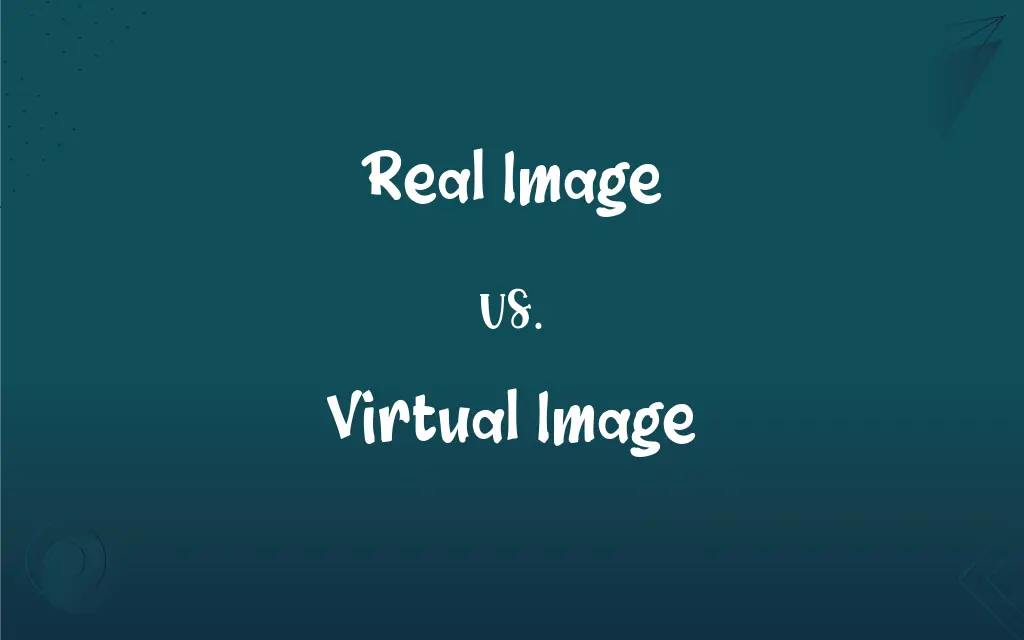Real Image vs. Virtual Image: What's the Difference?
Edited by Janet White || By Harlon Moss || Updated on October 10, 2023
Real images are formed when light rays converge, and they can be projected on a screen; virtual images occur when light rays diverge, and they cannot be projected.

Key Differences
A real image is generated when light rays physically converge at a point after interacting with an optical device, such as a lens or mirror. In contrast, a virtual image is formed when light rays appear to converge at a point but do not physically do so.
Real images can be projected onto a surface since the light rays meet at a physical location in space. On the other hand, virtual images cannot be projected onto a surface as the light rays do not actually converge, even though they appear to do so.
The nature of a real image can vary, being either inverted or upright, depending on the optical setup and the object’s location relative to the focus. In contrast, a virtual image is always erect, appearing right-side-up regardless of the setup or object placement.
A real image is perceived when looking through a converging lens or at a concave mirror (under certain conditions). In opposition, a virtual image is typically witnessed when observing oneself in a flat mirror or looking through a diverging lens.
Real images often exhibit variations in size, being magnified or reduced based on the object’s distance from the lens or mirror. Alternatively, virtual images typically present a magnification factor greater than one, making the image larger than the object.
ADVERTISEMENT
Comparison Chart
Light Ray Convergence
Actual convergence of light rays
Apparent convergence of light rays
Projectability
Can be projected on a screen
Cannot be projected
Orientation
Can be inverted or upright
Always upright
Formed by
Converging lenses, concave mirrors
Diverging lenses, convex mirrors
Size Variation
Can be magnified or reduced
Typically magnified
ADVERTISEMENT
Real Image and Virtual Image Definitions
Real Image
Real images can be inverted or upright, contingent upon the object’s relative position to the optical device.
The telescope formed an inverted real image of the distant star cluster.
Virtual Image
A virtual image is an optical illusion created by the apparent, but non-actual, convergence of light rays.
Your reflection in the bathroom mirror is a virtual image.
Real Image
Real images occur when light rays emanating from a point converge at another point.
Through the lens, the real image appeared inverted on the other side.
Virtual Image
Virtual images are typically formed by diverging lenses or reflected off surfaces like flat or convex mirrors.
The makeup mirror created a larger, upright virtual image of her face.
Real Image
Real images are palpable, allowing them to be captured on a physical medium, like a film or screen.
The camera lens projected a real image onto the sensor, capturing the landscape.
Virtual Image
A virtual image cannot be projected onto a surface because the light rays don’t actually meet.
He learned that a virtual image is elusive, vanishing when trying to capture it on paper.
Real Image
Real images are generated through actual light path convergences following reflection or refraction.
The concave mirror focused the light rays, generating a real image at the focal point.
Virtual Image
Virtual images are always erect and situated on the same side of the optical device as the object.
Through the binoculars, he saw a virtual image that was magnified and upright, providing a closer view of the bird.
Real Image
A real image is a reproduction of an object via light that can be formed on a surface.
The projector created a real image of the slide on the white screen.
Virtual Image
A virtual image forms where light rays appear to originate after diverging or reflecting, not where they actually do.
In the experiment, the lens caused the light to diverge, crafting a virtual image that appeared behind the object.
FAQs
Why can’t virtual images be projected?
Virtual images can’t be projected because the light rays don’t physically converge.
What is a real image?
A real image is a tangible reproduction of an object formed by the actual convergence of light rays.
Can a real image be smaller than the object?
Yes, a real image can be magnified or reduced, depending on object distance and lens/mirror type.
Where is a real image located in relation to a lens or mirror?
A real image can be located on the opposite side of a lens or mirror from the object.
Can real images be projected onto a screen?
Yes, real images can be projected onto a screen due to the physical convergence of light.
What types of mirrors form real images?
Concave mirrors can form real images under certain conditions.
Are real images always formed by concave mirrors?
No, real images can be formed by concave mirrors, but not always—it depends on object placement.
Can we see a real image without a screen?
Generally, a screen or medium is needed to view a real image, though it might be perceptible without one in some situations.
Why do virtual images appear to be located where they aren’t?
Virtual images appear where light rays seem to converge, not where they physically do.
Can both real and virtual images be formed with a single optical setup?
Yes, depending on object distance and optical characteristics, setups can create real or virtual images.
Can I see virtual images without any aids?
Yes, virtual images can typically be seen without the need for screens or additional tools.
Are real images always inverted?
No, real images can be either inverted or upright, depending on the object’s position relative to the optical device.
When do convex mirrors form virtual images?
Convex mirrors always form virtual images, regardless of object placement.
Is your reflection in a flat mirror a real or virtual image?
Your reflection in a flat mirror is a virtual image.
What determines the size of a real image?
Object distance, focal length, and lens/mirror curvature influence the size of a real image.
Can virtual images appear in different orientations?
No, virtual images are always upright.
Can a real image be formed by a convex mirror?
No, convex mirrors always form virtual images.
How is a virtual image formed?
A virtual image is formed by the apparent convergence of light rays, which don’t actually meet.
Are virtual images always larger than the object?
Not always, but virtual images are often magnified, especially in devices like magnifying glasses.
Can virtual images be formed using lenses?
Yes, virtual images can be formed using diverging lenses.
About Author
Written by
Harlon MossHarlon is a seasoned quality moderator and accomplished content writer for Difference Wiki. An alumnus of the prestigious University of California, he earned his degree in Computer Science. Leveraging his academic background, Harlon brings a meticulous and informed perspective to his work, ensuring content accuracy and excellence.
Edited by
Janet WhiteJanet White has been an esteemed writer and blogger for Difference Wiki. Holding a Master's degree in Science and Medical Journalism from the prestigious Boston University, she has consistently demonstrated her expertise and passion for her field. When she's not immersed in her work, Janet relishes her time exercising, delving into a good book, and cherishing moments with friends and family.































































